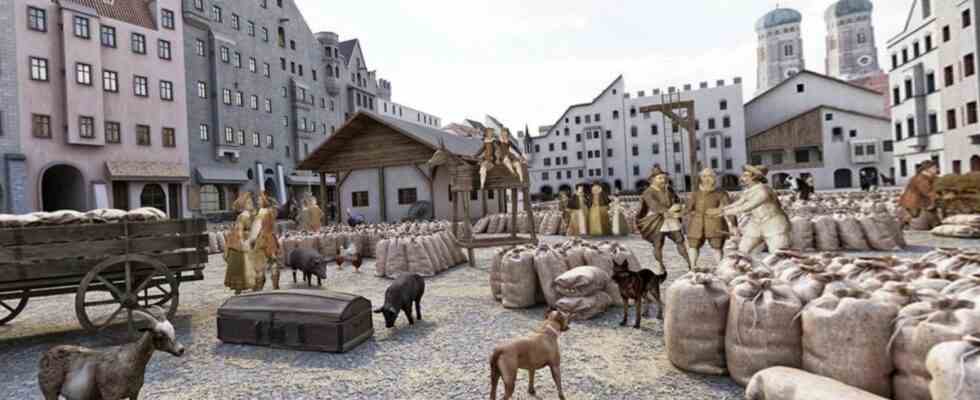Who would have thought that the boundary between the Middle Ages and the 19th century runs almost exactly between the Fish Fountain and the Marian Column? If you look in the direction of Alter Peter, you will see a tram on the left and opposite the Hugendubel the D’Orville wine shop, on the right in the middle of the Getreidemarkt instead of the Marian column there is still the gallows, horse droppings are lying on the ground, and two poor guys have to ride the disgraceful donkey .
Marienplatz in 1870: the horse droppings and gallows have disappeared from the cityscape.
(Photo: Weis(s)er Stadtvogel)
Well, strictly speaking, you can only see all of this on the 3-D tour that Heinz Taubmann and his fellow campaigners from the “Weis(s)en Stadtvogel” came up with. Thanks to modern technology, they let the VR-wearing guest travel to several places in the old town at a specific point in time in the past: to Marienplatz 1570 and 1870, at the Platzl he is amazed at how different the Hofbräuhaus looked in 1895, Max-Joseph-Platz of 1802 he would hardly have recognized without the State Opera, on November 9, 1933 he was present at Odeonsplatz when Hitler inaugurated the memorial for the victims of the Hitler putsch (keyword: Viscardigasse, which had become known as “Drückebergergasse”), before it opened on November 9th, 1933 Rindermarkt then gets really harsh: bombing raids in 1944, the Old Peter protruding from the rubble, the squadrons of planes up in the sky, a bomb is hurtling towards the visitor directly above us… It’s a good thing that you can simply take off your glasses again.
A city tour: Also something that had almost been erased from memory because of the corona virus. “Many have simply forgotten that there are guided tours,” says Heinz Taubmann, the manager of the “Weis(s)en Vogel”, “but adventure tours are fun”. He himself has been giving the night watchman, one of the most popular tours, for many years, and to show everyone that he survived the plague and is doing his rounds every day again, he now comes to Marienplatz in broad daylight with two dozen beautifully costumed colleagues. The message to the assembled Glockenspiel audience and all other passers-by: We’re back! Book us!
Around 50 different tours are on offer, on foot, by bike or by bus: “Executioners, Whores, Witches”, “Mysterious Old Town – Munich in the Middle Ages”, “Mysterious Signs”, “Strong Women”, “Myths & Legends of the Old Town”, crime scene stories or the popular culinary city tours: In addition to the Viktualienmarkt tasting tour, there are also delicacies in Haidhausen, Schwabing, in the Westend, in the Glockenbachviertel and recently also in the booming Schlachthofviertel.
And what was it like here before? One of the historically dressed city guides with virtual reality glasses in the inner courtyard of the town hall.
(Photo: Leonhard Simon)
The people of Munich – according to Taubmann, most of the guests are locals – seem to have forgotten all that. “Despite the great weather in the past few weeks, the phone has been pretty quiet,” complains the Stadtvogel boss. “At the moment we have maybe 20 percent of the bookings like before Corona.” The various lockdowns have given him and his colleagues a professional ban for around a year. Of the approximately one hundred city guides and 20 actors, only about half are left.
The acting industry in particular has been hit hard by the pandemic, says Jacqueline Schiesser, who has thrown herself into a magnificent dress as a courtly maid. Otherwise she is out and about with an Ikea bag full of clothes and sometimes bursts into the middle of a tour to act out a scene: Teufelstritt in the Frauenkirche, Renata von Lorraine in the Michaelskirche, Vera Brühne or Rosi from the restricted area. “Besides, I’ve shifted to writing novels,” she says. Her latest work is called “A Tale of Gods and Monsters: A Viking Story” and is not for the faint of heart and is set in the year 909.
A trip into the future is also possible at Jakobsplatz
They are all interested in history as they stand in front of the town hall. There are also a few novices: Katharina Frenck and Ben Neudeck are right in the middle of the four-month training course to become city guides and “thankful that we’re not in Augsburg,” says Neudeck: “That would be another 800 years more to learn – good: Wolfsburg would have been shorter.” Two exams and three rehearsal tours have to be completed, explains the man dressed as an Augustinian beer monk. He’s actually an educator, “but I walk around Munich a lot, I’m kind of a city stray.”
The monk’s habit looks great on him, but hardly anyone can compete with Heinz Taubmann’s rather perfect night watchman outfit: mighty halberd, black and yellow doublet, hat with feather, knee-high boots, drinking horn on his belt and of course the lantern for the night. Where did he get all this from? “Mum tailors,” he says, and she does it very well and precisely, “and then there’s the State Opera’s costume sales. We always make sure that we’re all there early enough to stock up.”
Apparently that worked out well last time. As varied and smartly dressed up as the colorful Stadtvogel troupe stands there in front of the town hall, you are only spoiled for choice. And once you get used to the initially somewhat dizzying effect of the 3D glasses, you will soon feel like you are right in the middle of historical events. However, the view is not only backwards, but also forwards: who would have thought that Jakobsplatz in the year 2100 would look so futuristic?

